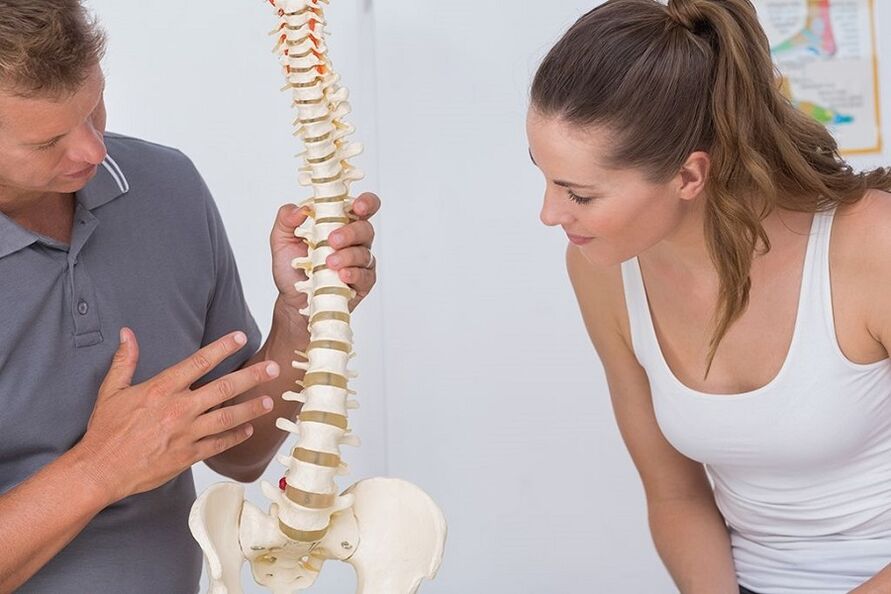According to medical statistics, osteochondrosis of the cervical spine is a fairly common disease in recent years. Every person at least once in his life has encountered his unpleasant symptoms.

The disease itself is a dysfunction of the intervertebral discs of the cervical spine. After all, it is in this part of the human spine that the maximum constant load occurs.
The cervical region consists of 7 discs. Due to his weak muscles and the constant loads on them, various injuries and interruptions at work can occur. Due to all these factors, osteochondrosis of the cervix begins to develop.
Types of diseases
Osteochondrosis is an insidious disease that may not appear for a long time. There are several stages in the development of this disease:
- grade 1 cervical osteochondrosis (manifested by initial spinal disorders);
- grade 2 cervical osteochondrosis (distance between cervical spine discs begins to decrease);
- grade 3 cervical osteochondrosis (complete destruction of the intervertebral disc ring occurs and severe deformation of the entire spine begins);
- grade 4 cervical osteochondrosis (the final stage of disease progression, which can lead to disability).
Causes of the appearance and development of the disease
Like any other disease, cervical osteochondrosis has its causes and developmental factors. Until a few decades ago, only the elderly were susceptible to this disease. Also, osteochondrosis of the neck hit men after the age of 40 who are engaged in heavy physical work.
Nowadays, neck osteochondrosis is becoming more common, affecting young people over the age of 20. There are many reasons for the development of diseases of the cervical spine and chest:
- existing excess weight;
- incorrect posture and, as a result, spinal curvature of 1 or 2 degrees;
- heavy physical work or professional sports, due to which various spinal injuries have been received;
- reasons that cause stress and severe emotional stress;
- weak muscles of the cervicothoracic region;
- sudden cessation of sport after prolonged exercise;
- work related to sitting at the computer or staying in one position for a long time.
If you find yourself with the reasons listed, then you are in the so-called risk group. In this case, it is necessary to prevent osteochondrosis of the cervical spine.

Manifestation of the disease
With osteochondrosis of one degree, a person feels virtually no symptoms of a developing disease. Only the initial tightening of the neck muscles begins.
Grade 2 osteochondrosis of the cervix usually manifests as minor pain that may occur in the cervical and thoracic segment. This occurs due to tightening of the nerve endings due to a decrease in the distance between the discs of the spine.
Grades 3 and 4 of the disease can not go unnoticed. In this case, the deformity of the spine can be observed with the naked eye, not to mention the sensations that a person experiences.
The main and most common symptoms of this disease include:
- persistent severe headaches;
- noise in the head;
- impaired movement and coordination;
- deterioration of vision and dental health;
- cerebrovascular accident, insomnia and various neurological problems.
At 1, 2, 3 or 4 degrees of the disease, the pain may spread to the shoulder and arm joint area. A feature of this symptom, which distinguishes it from other diseases, is that the discomfort changes its strength and concentration depending on the position of the neck and head curves.
Disease syndromes
All the symptoms that appear in osteochondrosis can be wrongly confirmed and, as a result, an incorrect diagnosis is possible. This is why, with existing symptoms, it is necessary to discover all the reasons for their occurrence. Thus, medicine recognizes several syndromes that distinguish between the causes of their origin:
Radicular syndrome
In this case, the nerves are compressed and the person feels pain and numbness in a part of the neck. Unpleasant sensations may spread to the back, shoulder area, as well as the arm;
Irriate reflex syndromes
Manifested by severe, unbearable pain in the back of the head, which spreads throughout the neck. Most often it occurs with a sharp movement or turn of the head;
Vertebral artery syndrome
In this case, the name speaks for itself. There is an itching of the artery and the person feels a strong throbbing headache, which may result in loss of consciousness or vomiting;
Cardiac syndrome
Manifested by increased heart rate, dizziness and loss of consciousness. Very often, in this case, a misdiagnosis is made and treatment of angina begins.

Treatment
With osteochondrosis, a person is always shown immediate treatment. His tactics are chosen depending on the degree of the disease. So at 1 or 2 degrees, complete recovery is possible after therapy. In the later stages, medical correction usually aims to prevent complications as well as improve the quality of life.
First aid
What to do when the first symptoms of the disease appear? First you need to relieve the pain from the cervicothoracic region. To do this, you need to take a regular analgesic, lie down or just relax.
The next step is to visit a doctor for accurate diagnosis and proper treatment.
Conservative treatment
With confirmed osteochondrosis, conservative treatment is usually prescribed. The patient is indicated taking anti-inflammatory, analgesic medication. It is possible to use different gels or ointments to relieve swelling and inflammation. Also, the doctor may prescribe a course of massages, therapeutic exercises. Physiotherapy for osteochondrosis of the cervical spine is prescribed in almost all cases.
Surgery
In rare cases, with severely advanced osteochondrosis, surgery is possible. In this case, the patient enters a state of sleep with the help of general anesthesia, after which the removal of bone formations between the discs of the cervicothoracic spine is performed. After manipulation, the patient is shown further conservative treatment or physiotherapy.
Preventive measures
Due to the decrease in the age of onset of cervicothoracic osteochondrosis, it is necessary for each person to carry out his prevention. This is especially true for those people who are at risk.
Important rules
Prevention of cervical osteochondrosis consists of following simple but very important rules:
- watch your posture, do not let it bend;
- do not expose the spine to heavy loads;
- you can not make sudden head movements;
- do not worry, avoid stress;
- do not chill, do not chill too much;
- get rid of bad habits, switch to the right food.
Special exercises
To protect yourself from such a disease, you need to do preventive exercises:
- place your palm on the forehead, tighten the neck muscles, then move the hand to the back of the head and repeat the exercise, you should do it for 7 seconds in 3 sets;
- place your palm on your temple, then tighten the neck muscles, repeat a similar action on the other hand, time, number of approaches is the same as in the first paragraph;
- get your head back, then slowly reach your chin to the chest area, you should do the exercise 3 times;
- turn your head in different directions - you should do this exercise slowly, without sudden movements;
- Turn your head back, first touch one shoulder with your ear, then the other, repeat the exercise 5 times.
If one or more symptoms of the disease appear, contact your doctor immediately. Maybe you will just be prescribed physiotherapy and this will be the end of it. Do not delay, do not start the disease.
Do your daily gymnastics. It is better to do elementary exercises than to suffer from illnesses later.
Ask your doctor how to sleep for cervical osteochondrosis. Follow all the rules, be healthy!

















































